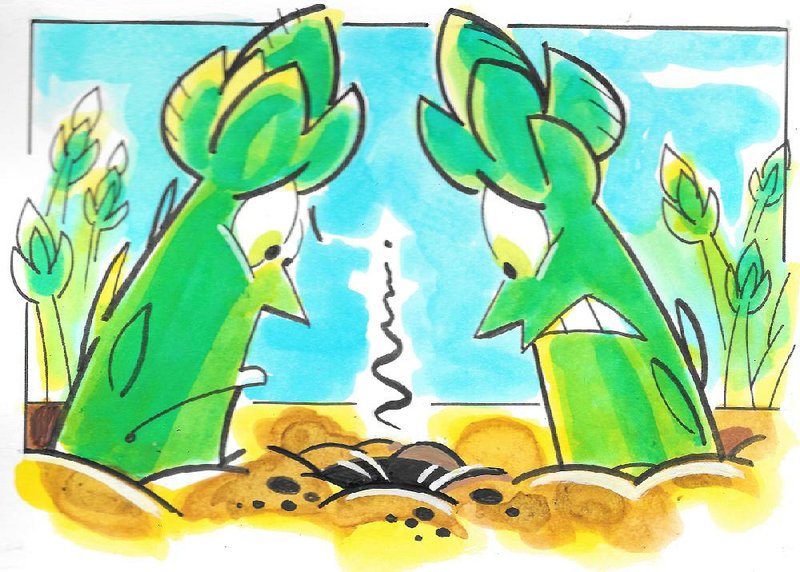Q When do I need to quit picking my asparagus? I have been harvesting heavily for two months. I know it needs a break, but it is so good.
A There is nothing better than fresh asparagus. Quit harvesting when the spears are smaller than a pencil in diameter. If you overharvest, it can wear the plants out so they produce poorly in future years.
Q I have a batch of irises that for years have had no plant blooms or perhaps one or two. Last fall I took them all up and mixed in additional soil to a replanted bed of 20 bulbs. In February I lightly fertilized the bed. This week I finally have one of the 20 iris plants with three beautiful white blooms. All the other plants have multiple, healthy leaves on them but no blooms. Nothing has changed. Why is this thus?
A We usually see non-blooming irises if they are grown in the shade or the rhizomes are too crowded. Irises will not bloom if they are not getting enough sunlight. They need six to eight hours per day, at the minimum, and more would be better. If they get too crowded, they won't bloom, but I assume you divided them when you replanted them. Iris plants should be divided in late July to early August. There should be two to three fans per division. A "fan" is the fan-shaped arrangement of leaves coming out of the iris rhizome. If you divide them too severely, to only one fan per division, they often will not bloom the next year. They need to build up more energy. You also need to make sure you have not planted the iris rhizomes too deeply. Unlike bulb-producing plants, many of which want their bulbs thoroughly buried, ideally you want the iris rhizome to be half exposed.
Q Do you know of any way other than continually snipping to get rid of crape myrtle suckers? I tried just letting some of them grow to branches, but that will take forever and looked so bad I finally cut them. Do you think I could put Roundup on some of the suckers without killing the entire plant?
A Some varieties of crape myrtles will sucker every year for their entire lives, while others don't produce any suckers. If you have a suckering variety, cutting out the suckers right beneath the soil surface once or twice a season should suffice. I do not recommend using Roundup as the suckers are attached to the mother plant, which could be damaged.
Q I have nine euonymus shrubs across the front of my house (east side). Last year one of them got infected and died before I noticed the problem. I then noticed some of the others were also beginning to look bad. I took some of the infected branches to the nursery and they told me that it was euonymus scale and sold me 55 percent malathion for treatment. I sprayed them twice (in the fall), and they looked better. Then in February I noticed three of them had become infected again and some branches were already dead. I sprayed them again with the malathion and removed the dead branches. They are now greening up and putting on new growth, but I think I can see the scale coming back. I started to spray again but noticed the instructions on the malathion say, "Do not apply more than two times a year." Is it safe for me to use more often? If not what can I do to kill this scale?
A If you grow the golden euonymus plants, expect to see euonymus scale every year. That is the limitation to growing this plant. Euonymus scale will not kill a plant overnight, but over time it will limit growth and overall vigor, which can lead to an early death. The way to identify the scale is to look at the backs of the leaves, the stems and in bad cases, even on the upper surface of the leaves. It will look like someone has sprinkled them with salt and pepper. Scale insects are difficult to kill with a contact spray -- which malathion is -- since the insects cover the undersurface of the leaves, the stems and other parts, It's tough to get thorough coverage. If the insecticide doesn't come in contact with the insect, it can't kill it. You may have knocked back some of the crawlers but not many of the adults. For scale insects it is better to use a systemic insecticide that can kill the insects as they feed. Orthene is one, imidicloprid (Merit, Fertilome Tree & Shrub Systemic Insect Drench, or Bayer Advanced Tree & Shrub insecticide) will do a great job.
Q Hi Janet, love your article in the Arkansas Democrat-Gazette (and your radio show in the old days). Can you tell me what summer annuals bloom a lot and can take full afternoon sun? These will be replacing my violas, which are glorious. Whatever it is probably needs to be a foot or less tall.
A The violas did bounce back nicely this spring and have been stunning in many gardens. For plants that are no more than 12 inches tall and can take full sun, consider replacing with vinca (periwinkle), lantana (look at mature sizes, because some get much taller, while others stay compact), and "Zahara" or "Profusion" zinnias in a wide range of colors. The double orange is stunning!
Janet B. Carson is a horticulture specialist for the University of Arkansas Cooperative Extension Service. Write to her at 2301 S. University Ave., Little Rock, Ark. 72204 or email her at
jcarson@arkansasonline.com
HomeStyle on 05/12/2018
